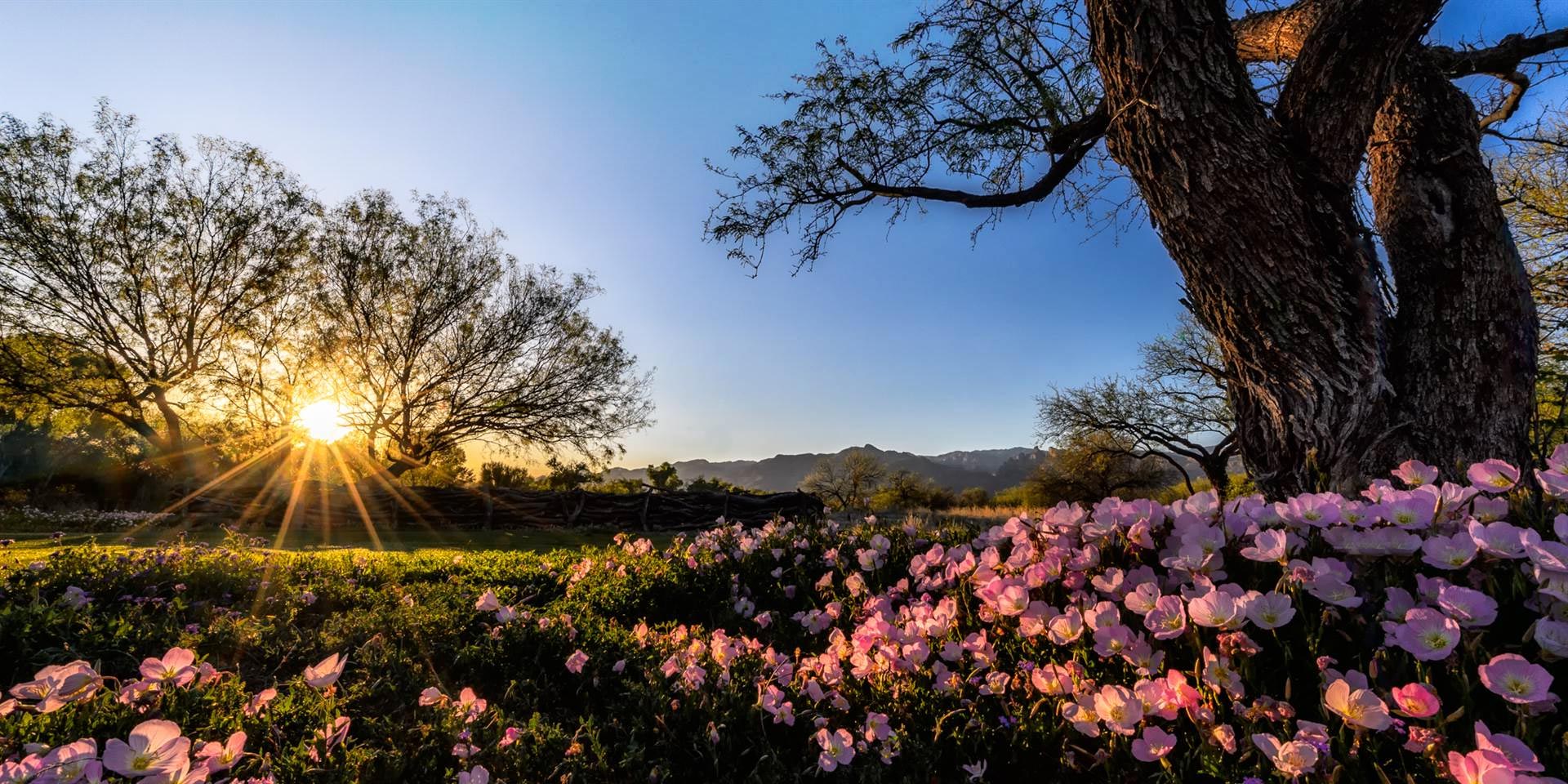Using Native Succession Plants for Restoration Projects
Posted Dec 28, 2020
by John Scheuring, Tucson Chapter, Arizona Native Plant Society, Chair, AZ Native Plant Society, Conservation Committee, jfscheuring@hotmail.com
reprinted from The Plant Press.
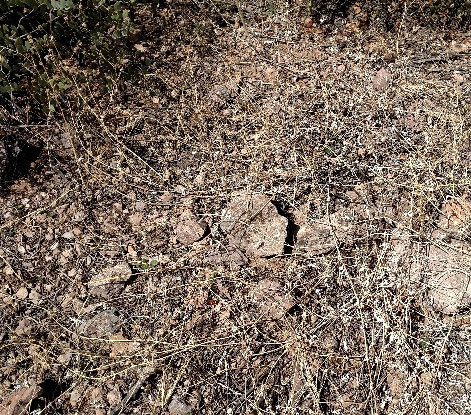
Trailing Four o’clock (Allionia incarnate). Photos courtesy Max Licher
Our gardening and landscaping efforts in the Sonoran Desert area often include the objective of establishing sustainable native plant communities on private and public properties and along roadsides. The transition from disturbed land to native plant communities takes many years and informed and sustained care to “keep the good guys and weed out the bad guys.” The key to success is knowing the plant species that promote long-term native plant establishment.
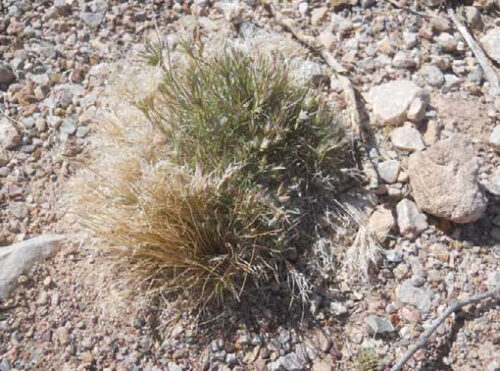
Fluffgrass (Dasyochloa pulchella). Photos courtesy Max Licher.

Fluffgrass (Dasyochloa pulchella). Photos courtesy Max Licher.
The Healers A few native species establish early and actually help heal disturbed soils and facilitate subsequent plant establishment and succession. They establish on poor and sometimes eroded soil, grow prolifically depending on available moisture, and leave behind abundant surface and root tissue after they die. Dead plant tissue serves to cool soil temperatures, diminish evaporation, promote soil wetting of even small rainfall moisture, and provide mulch for both annual and perennial plant germination and establishment.
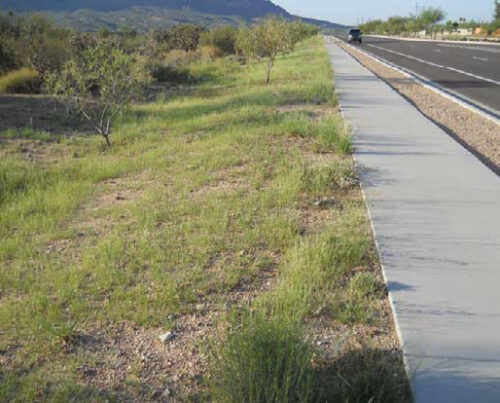
Needle Gramma (Bouteloua aristidoides).
Notable native healer species are Trailing Four O’clock (Allionia incarnata), Fluffgrass (Dasyochloa pulchella), Needle Grama grass (Bouteloua aristidoides), Sixweeks and Purple Threeawn grasses (Aristida adscensionis and A. purpurea), and Triangleleaf Bursage (Ambrosia deltoidea).
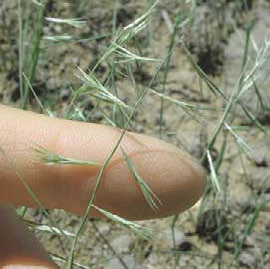
Needle Gramma (Bouteloua aristidoides).
Trailing Four o’clock is a common short-lived perennial species occurring on Sonora Desert bajadas and slopes. It can grow prostrate runners up to 15 feet long when there is adequate moisture in the early fall. Aboveground plant parts wither and die during droughty periods. Although most of its growth occurs in September-October, it has been observed growing, and flowering every month of the year in Finger Rock Canyon in the Santa Catalina Mountains. Trailing Four o’clock readily establishes after dense buffelgrass has been suppressed on slopes and in areas undergoing restoration following landscape disturbance. Its prostrate growth allows unimpeded growth of young perennials, including woody trees and bushes.
Fluffgrass is a bunchgrass occurring extensively across the southern southwestern United States and into central Mexico on sandy and rocky soils up to 6,000 feet elevation. Although it is common, it is largely overlooked due to its diminutive size (less than 15 cm) and modest appearance. Fluffgrass readily establishes on poor and disturbed soils and can thrive with very little rainfall, due to its rapid growth and development. Fluffgrass propagates itself by seed and stolons. After going to seed, aboveground plant parts wither and die but plants quickly recover following even scant rains occurring anytime during the year. Fluffgrass provides considerable mulch for more robust plants, especially the threeawn grasses.
Needle Grama grass is a fast-growing summer annual that commonly appears in the southwestern United States and northern Mexico below 3,000 feet elevation. It germinates abundantly in August and prefers growing on exposed bare soil of disturbed or sparsely vegetated landscapes. Rarely does it grow taller than 30 cm. The ground coverage during monsoon rains helps prevent erosion and promotes the germination and growth of other native plants.
Sixweeks and Purple threeawn grasses often occur together during early plant succession, with the dead annual Sixweeks threeawn plants commonly providing mulch and umbrage for the growth of the perennial and taller Purple threeawn grass. Both species are bunch grasses. The Sixweeks threeawn has shallow roots and is usually limited to 40 cm. Purple threeawn is often taller than 80 cm and develops extensive fibrous roots that serve to discourage rainwater runoff, thus retaining moisture, and increasing moisture infiltration in the soil.
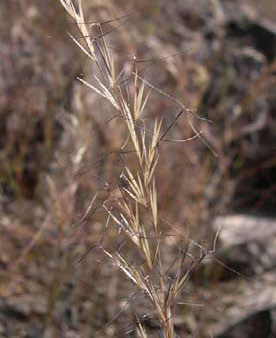
Sixweeks threeawn (Aristida adgcensionis). Photo courtesy Max Licher
Triangleleaf Bursage (Ambrosia deltoidea) is the climax subbrush of bajadas of the Sonoran Desert, wherever saguaros grow. It is also abundant in desert grasslands and creosote flats, along with its more drought-hearty related species White Bursage (Ambrosia dumosa). It occurs on elevations of 1,000–3,000 ft. Its extensive roots grow up to 3 feet deep. During plant succession, its roots outcompete other species such as Brittlebush (Encelia farinosa) for moisture. Triangleleaf Bursage can live over 50 years and is drought deciduous, sloughing off leaves and stems during dry periods and putting on lush growth during periods of adequate moisture. Triangleleaf bursage serves as nurse plants to various cacti, especially Mammallaria species. Its accumulation of litter softens nearby soil, which in turn attracts insect and rodent dwellers. With enhanced soil water infiltration, soil erosion rarely occurs in landscapes well-populated with Triangleleaf Bursage.
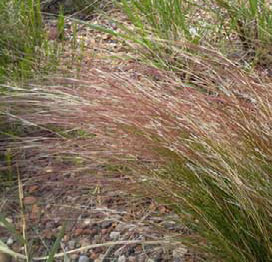
Purple threeawn (A. purpurea). Photos courtesy National Park Service.
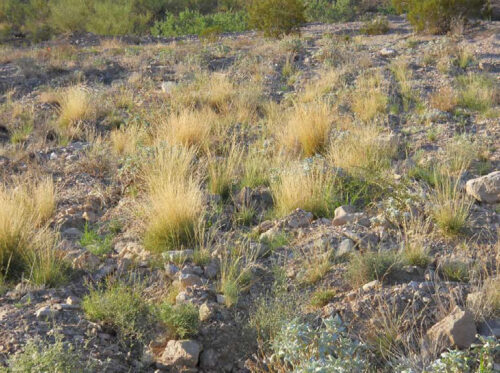
Purple threeawn (A. purpurea). Photos courtesy Max Licher
Discussion and Conclusions While hundreds of plant species are found in the Sonoran Desert, there is a handful of very common keystone species that “make the music for the dance,” healing damaged landscapes, and enabling other plant species to establish and thrive. Any effort to harmonize landscapes with surrounding desert needs to encourage these and similar “healer” species to thrive. The best approach is to recognize the key healer species and favor their growth by excluding invasive species and weedy natives. Given a chance, these native healers will do their job!

Triangleleaf Bursage (Ambrosia deltoidea).
Due to seed collection and production difficulty, neither Trailing Four O’clock nor Fluffgrass are available from desert seed providers. Seed of all the other above mentioned species can be obtained from large commercial seed businesses.

